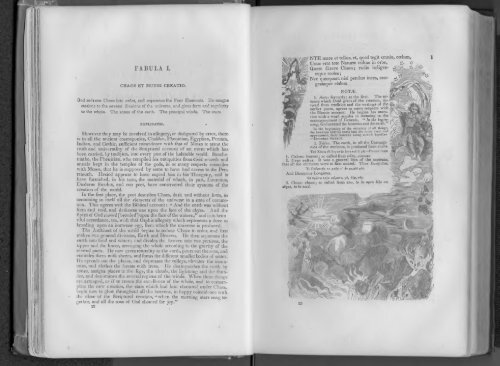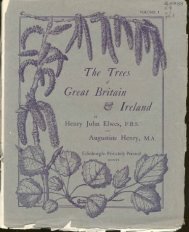THE METAMORPHOSES OF PUBLIUS OVIDIUS NASO
THE METAMORPHOSES OF PUBLIUS OVIDIUS NASO
THE METAMORPHOSES OF PUBLIUS OVIDIUS NASO
You also want an ePaper? Increase the reach of your titles
YUMPU automatically turns print PDFs into web optimized ePapers that Google loves.
FABULA I.<br />
CHAOS ET MUND1 CREATIO.<br />
3od redtces Chaos into order, and separates the Four Elements. He assigns<br />
stations to the several divisions of the universe; and gives form and regularity<br />
to the whole. The zones of the earth. The principal winds. The stars.<br />
EXPLICATIO.<br />
However they may be involved in allegory, or disfigured by error, there<br />
is in all the ancient cosmogonies, Chaldee, Phenician, Egyptian, Persian,<br />
Indian, and Gothic, sufficient coincidence with that of Moses to attest the<br />
truth and universality of the Scriptural account of an event which has<br />
been carried, by tradition, into every part of the habitable world. Sancho-<br />
niatho, the Phenician, who compiled his antiquities from civic records and<br />
annals kept in the temples of the gods, in so many respects coincides<br />
with Moses, that he is supposed by some to have had access to the Pen<br />
tateuch. Hesiod appears to have copied him in his Theogony, and to<br />
have furnished, in his turn, the material of which, in part, Lucretius,<br />
Diodorus Siculus, and our poet, have constructed their systems of the<br />
creation of the world.<br />
In the first place, the poet describes Chaos, dark and without form, as<br />
containing in itself all the elements of the universe in a state of commo<br />
tion. This agrees with the Biblical account: " And the earth was without<br />
form and void, and darkness was upon the face of the abyss. And the<br />
Spirit of God moved [brooded] upon the face of the waters;" and is in beau<br />
tiful accordance, too, with that Orphic allegory which represents a dove as<br />
brooding upon an immense egg, from which the universe is produced.<br />
The Architect of the world begins to reduce Chaos to order, and first<br />
makes two general divisions, Earth and Heaven. He then separates the<br />
earth into land and waier; and divides the heaven into two portions, the<br />
upper and the lower, arranging the whole according to the gravity of the<br />
several parts. He now cfives rotundity to the earth, pours out the seas, and<br />
encircles them with shores, and forms the different smaller bodies of water.<br />
He spreads out the plains, and depresses the valleys, elevates the moun<br />
tains, and clothes the forests with trees. He distinguishes the earth by<br />
zones, assigns places to the fogs, the clouds, the lightning and the thun<br />
der, and determines the several regions of the winds. When these things<br />
are arranged, as if to crown the excellence of the whole, and to contem<br />
plate the new creation, the stars which had lain obscured under Chaos,<br />
begin now to glow throughout all the heavens, in happy coincidence with<br />
the close of the Scriptural creation, " when the morning stars sang to<br />
gether, and all the sons of God shouted for joy."<br />
22<br />
NTE mare et tellus, et, quod tegit omnia, cesium,<br />
Unus erat toto Naturae vultus in orbe,<br />
Quern dixere Chaos; rudis indigestaque<br />
moles;<br />
Nee quicquam nisi pondus iners, congestaque<br />
eodem<br />
NOT.E.<br />
1. Ante: formerly; at the first. The ac<br />
count which Ovid gives of the creation, de-<br />
rived from tradition and the writings of the<br />
earlier poets, agrees in many respects with<br />
the Mosaic account. He begins his narra<br />
tion with a word similar in meaning to the<br />
commencement of Genesis, " In the legin-<br />
ning, God created the heavens and the earth.<br />
In the beginning of the creation of all things<br />
the heavens and the earth had lire ?:iine lonn nnd<br />
appearance, their nnlures being mixed together<br />
DlODOBLS SlCULUS.<br />
1. Tellus. The earth, in all the Cosmogo<br />
nies of the ancients, is produced from chaos.<br />
ToCXdou{iiSujoTr;pi(rrnco! It yfi. 1'ilouMTltIB<br />
1. Calum: heaven; so called from lp, irfp.<br />
3. Chaos: chaos; so called from Xou, to la open like an<br />
abyss, to be void.













